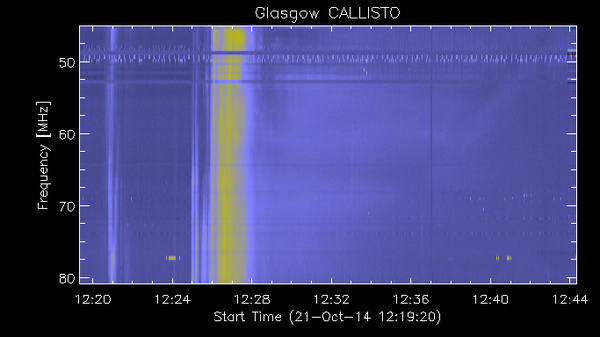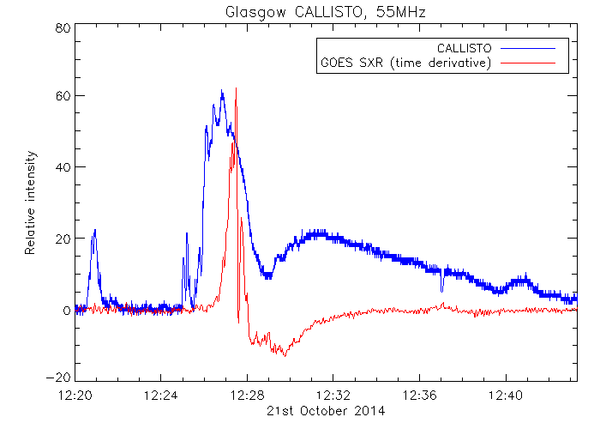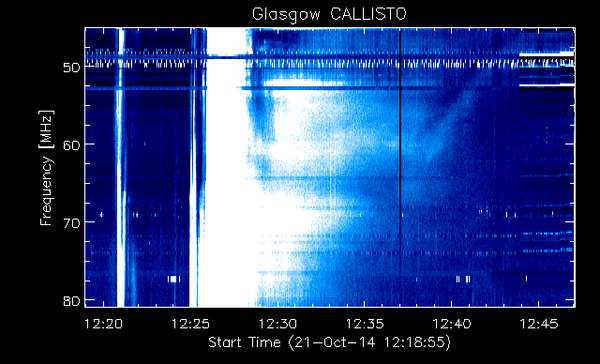Glasgow Callisto and CMEless type II bursts
From RHESSI Wiki
| Nugget | |
|---|---|
| Number: | 246 |
| 1st Author: | Peter Wakeford |
| 2nd Author: | Hugh Hudson |
| Published: | February 16, 2015 |
| Next Nugget: | TBD |
| Previous Nugget: | [1] |
| List all | |
Contents |
Introduction
The techniques of radio astronomy let us study many aspects of solar flares and coronal mass ejections (CMEs). Generally these observations reflect dramatic plasma effects in the solar atmosphere, such as particle acceleration.
In the conventional picture, a CME traveling out of the lower solar atmosphere and into the solar wind drives a coronal shock wave that produces a [type II ("slow drift")] radio burst, which then accelerates solar energetic particles SEPs that can fill the heliosphere and often cause trouble for spacecraft. In an earlier Nugget we noted the development of NOAA active region 2192, in October 2014; this region produced a remarkable series of major flares but few CMEs and no SEPs. We were thus quite surprised to find that our Glasgow Callisto radio observatory had actually detected type II bursts from some of these flares.
e-Callisto and Glasgow Callisto
The e-Callisto project is a global development of over 70 solar radio spectrometers scattered widely around the world, organized brilliantly from Switzerland by Christian Monstein. By providing an inexpensive and easily maintained receiver, this project aims to provide full-time broad-band monitoring of solar radio bursts. The Glasgow CALLISTO site, initiated in 2012, uses a log-periodic antenna on an tracking mount, allowing automated observation though the day at frequencies of around 47 to 80 MHz. Few sites within the larger e-Callisto network observe at such long wavelengths, but they turn out to be crucial for the detection of the type II solar radio bursts.

Figure 1 shows the event that caught our attention: SOL2014-10-21T12 (C4.4) (see our explanatory Nugget for this nomenclature). Such events rarely happen with such feeble flares, and in this case there were two events in quick succession from the same active region, but minimal CME development. EUV movies from the [SDO AIA] telescope, and other sources, showed these flare disturbances to have narrowly focused ejecta, suggestive of plasma flow along existing field large-scale (open) magnetic fields, rather than eruption of the field itself as in a classical CME. Nevertheless, well-developed type II bursts resulted.
Type II bursts without CMEs?
Initial estimates indicate that the Type III burst was travelling at 0.1c. [some solar physics. Just checking I can edit the wiki]
Conclusions
Live data from the Glasgow CALLISO can be seen here, and back data can be downloaded by following the links. CALLISTO data can be analysed using IDL routines, or using the nice new Python package SunPy. [some text. Virtues of e-callisto; failure of Irish site to confirm. ]
References
| RHESSI Nugget Date | 16 February 2015 + |
| RHESSI Nugget First Author | Peter Wakeford + |
| RHESSI Nugget Index | 246 + |
| RHESSI Nugget Second Author | Hugh Hudson + |

